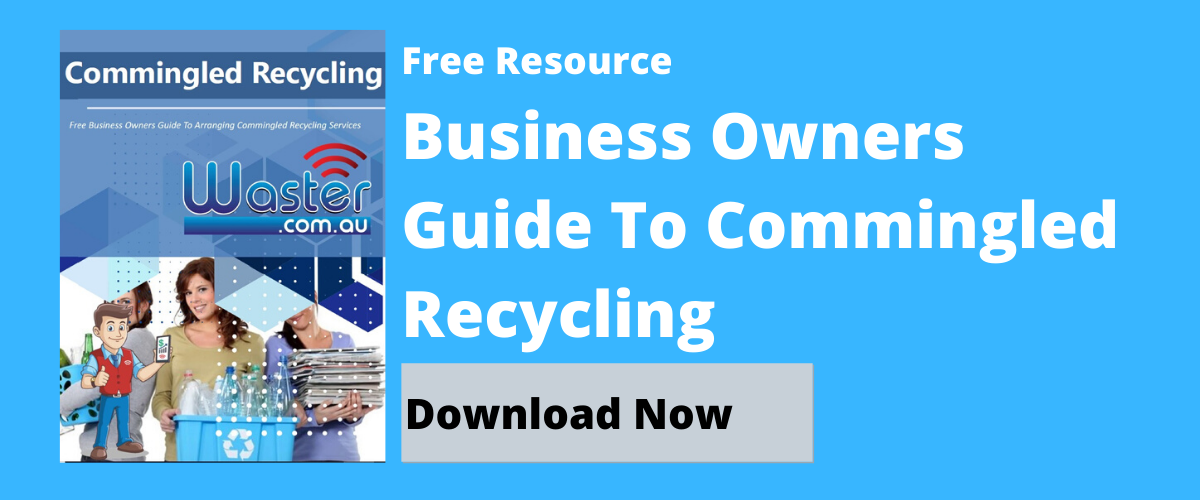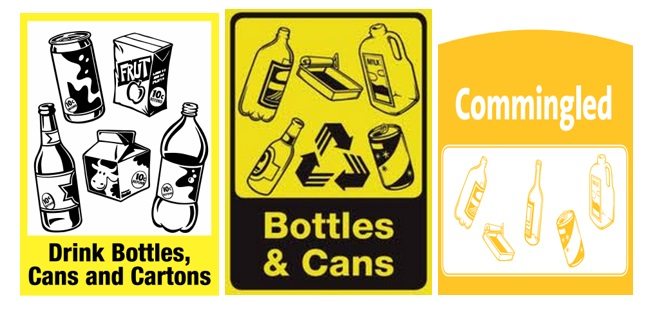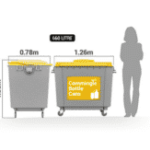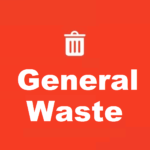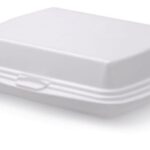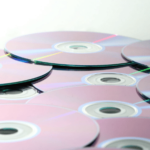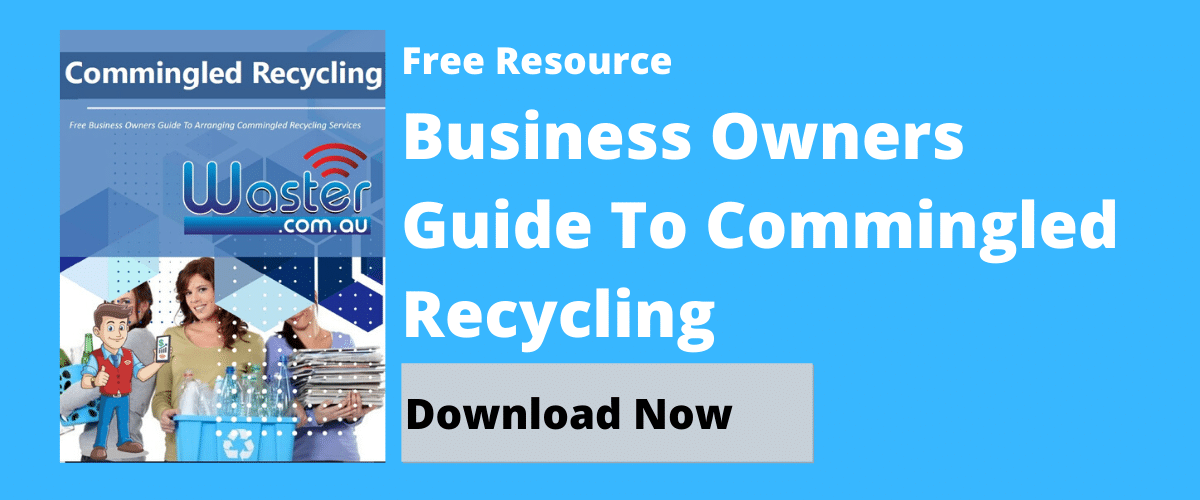Commingled Recycling 2021 🍾: Why Commingled Bin Is Key To Recycling
Energy Disrupter
Commingled recycling: Waster is a big advocate for using commingled bins in many circumstances and argue that a smart commingled recycling program can be a key step in helping you business boost its overall recycling and cost minimisation performance.
>Download Now: Free PDF Business Owners Guide To Commingled Recycling Bin Services
Commingled recycling bin – what exactly is it?
A commingled recycling program is one of the most versatile waste management services currently available in Australia as many differing items can be accepted in the waste commingled bin.
Commingled recycling meaning / what is commingled recycling?
Most food and beverage containers such as plastic bottles, glass jars, aluminium and steel cans are all accepted.
In 2021 – return and earn schemes are becoming much more common and accepted throughout Australia – boosting recycling for bottles and cans. For larger commercial purposes – you will likely require a commingled recycling bin.
Implementing a commingled recycling bin service can be a perfect secondary partner to a standard General bin waste services and also a recycling cardboard and paper collection service. This can be very useful for waste management in pubs and clubs.
We have published a number of blog posts recently on the best way to set up a waste management plan for your business to improve your environmental / recycling performance as well as reduce your costs. You can also see our article on obtaining rebates for Sydney recycling.
Prior to implementing a commingled service to recycle waste, you should check out our blogs on the potential to get cheap or even free cardboard recycling in 2021. You can also check out our informative blog on the best wheelie bin sizes to use for your business to best match your exact needs.
Why is a commingled bin a logical “next step” in 2021?
When a business starts along the journey of reducing waste management costs and boosting recycling – implementing a cardboard collection can be the easiest first step. This will likely reduce the volume of general waste by enabling large, bulky cardboard boxes to be removed from the bin.
The next step is to remove commingled waste – similar to what Australian households are getting used to with their home commingled bins.
Commingled recycling meaning / what is commingled recycling? By removing bottles, cans, plastic and glass it is possible to reduce the total cost of waste management (check out our article on whether a glass collection service could be useful for your business – Sydney waste disposal).
As can be seen from our online waste services shop – the cost for a commingled service can be considerably lower than a collection of a general waste bin of the same size. For example, in Sydney metro (in Mar 2021)- a 1100 General Waste bin collection (once per week) costs $41.00 (for a restaurant). In comparison an 1100 Commingled bin at the same location and frequency would cost only $31.20. This difference offers room for significant cost savings for your business.
You can book your bin online in three different sizes:
240 litre commingled recycling bin
660 litre commingled recycling bin
1100 litre commingled recycling bin
Colours and branding of Commingled bin
In Australia – commingled recycling bins are coloured yellow:
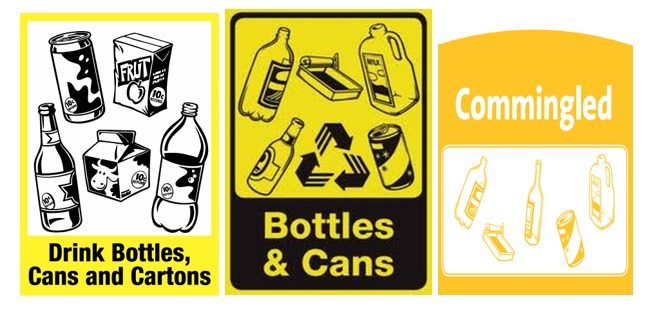

The colour scheme ensures staff are always clear about which bin to use for which waste stream.
You can get instant access to free downloadable garbage bin stickers here to boost your recycling performance.
How to book your commingled service
The easiest way to compare prices and book your commingled recycling program (also commonly spelled co-mingled) service is through our online model. You can access our services and compare prices for metro regions including Canberra, Sydney, Wollongong, Melbourne, Perth.
We will be doing an article shortly on the importance of recycling in Wollongong – reflecting the very expensive waste disposal costs there. Waste services Wollongong has the highest waste disposal costs in Australia.
You can also see our blog here on whether you will even need to have rubbish removed in the future!
Yellow bin mixed recycling: because Mr Waster is an extremely cultured type of person, he was recently watching the highly regarded French language movie trilogy “Three Colours” – for those who have not seen the movies – it is based on the colours of the French flag – Blue, white and red and deals with such themes as liberty, equality, fraternity.
Seeing as Mr Waster is interested in helping small and medium Australian businesses boost recycling – he thought he would do a series of blogs called – “Three colours – bins”. What do you think?
Waster offers waste management and recycling services from sanitary units to 4.5m general waste bins on flexible 30 day agreements, low costs and excellent customer service in all metro regions throughout Australia.
You can check out our commingled bin options through our online waste shop by pressing the button below:
We will start with Yellow:
Yellow bin mixed recycling to help reduce your business waste spend
Commingled (also spelled co-mingled) or mixed recycling is probably the most versatile recycling service available to most Australian small businesses as most containers can be collected in the same bin.
Brisbane City Council has published a useful document helping people work out how they can recycling more – whilst the booklet is aimed at residents – it can also be useful for business owners.
What is commingled recycling? Commingled recycling meaning. You can dispose of mixed, clean containers such as newspapers, brochures etc, cardboard packaging, milk and juice cartons, plastic bottles or containers, glass bottles and jars, steel or aluminium cans.
If you have large quantities of say glass (such as if you operate a bar or restaurant – you may want to consider a crushed glass collection).
The mixed recycling bin should not contain items such as food scraps or waste, plastic bags, polystyrene etc – see post on recycling centre. Check out our recent blog on waste disposal Melbourne.
Also – see the blog on resource recovery centre for info on how the commodities collected are processed.
A commingled recycling program can be a core part of a waste management strategy – see our blog on the topic in 2021 at business waste management Australia.
Conclusion:
Using a commingled recycling bin can be the perfect next step in your recycling journey after a cardboard bin,
It is practical and convenient and means you can put numerous recycling commodities in the same bin.
It is best practise to rinse the items first.
The only real no-nos for this bin are as below:
Do not include bagged waste – all items should be lose. If the waste is bagged it may be rejected by the collection truck.
No organic waste or general garbage – this will mess with the recycling process.
You can check out the short instructional video as below detailing what should be and what should not be included in a yellow recycling bin on pickup day:
[embedded content]
If you have been listening to the radio or reading the newspaper in recent weeks – you may be aware about a crisis in the Australian bin service industry that is starting to cause disruptions all over the country.
Ipswich council in Brisbane metro announced last week – that they would be putting an end to the commingled or mixed recycling bin service for residents for the immediate future.
In today’s blog – we will take a look at what is behind this situation and what are the implications.
Waster caters to small and medium Australian businesses.
Waster is a waste and recycling company – providing reliable recycling and general waste bin service collections to small and medium businesses.
We operate in all major Australian cities – and provide our services on flexible 30 day agreements. This means you do not need to sign a restrictive multi-year contract for your bin service.
See our blog on Ipswich waste services for your business needs.
You can check out our prices and book online today – by accessing our online waste services shop today. Simply press the blue button to get started now:
Why are some councils cancelling their recycling bin service?
As a resident or business in an Australian urban area – you will have become used to the flexibility and convenience of a yellow commingled recycling bin.
This is the bin that can take bottles, cans and packaging.
However, due to the collapsing prices for recycled commodities – and the recent changes in legislation by China – low quality mixed recycling is no longer being exported to China for processing.
What is Ipswich Council saying?
Quoting the ABC:
“The Council said on Wednesday China’s import ban on recycling and the rising level of contaminated or non-recyclable rubbish in yellow bins meant it had become too costly for the city to recycle, so from now everything placed in yellow bins would go straight to landfill.”
“More than half of the items being placed in Ipswich yellow top bins has been unrecyclable waste, and the city’s kerbside collections had already been going to landfill for four weeks.”
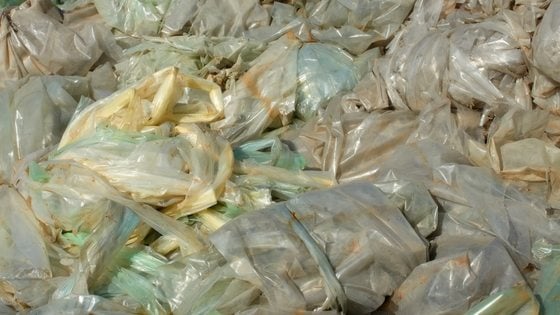

The council is the first in Australia to take this step – but maybe they are just being more open with their constituents than other councils:
“The existing methodologies of recycling are not working — they’re short-term, they’re not sustainable — we need some long-term strategies.”
“Cr Antoniolli said the council would run a campaign to better educate residents about what items can and cannot be recycled. The cost is not the issue — the issue is contamination.”
The major issue is the contents of the recycling bins are including too much general rubbish – i.e. items like plastic bags, burger wrappers and pizza boxes (we will cover pizza boxes in a future blog). See more on whether pizza boxes can be recycled here.
See our new blog on how AI could help decrease contamination.
Conclusion – What is the next step?
There is not an easy solution.
Ipswich will be the first of many councils to implement big changes.
Low quality recycling has been turned away by China – and there is currently no real recycling solution in place in this country. Even if it was recycled here – there is not enough manufacturing anymore to actually use the commodities.
We need a real national solution that covers circular economy, council procurement, residents responsibility for what goes in the bin, new recycling facilities and an examination of our economy in the 21st century.
The reality is a new clean economy – where manufacturing is performed off shore – also offshores the recycling and waste issue.
As always – what can not continue, must end – and it just ended.
[embedded content]
Co-mingled Waste Recycling: At Waster – we love to promote recycling in all it’s forms – and co-mingled waste recycling is one of the easiest, most common and best value recycling systems available for small and medium Aussie businesses. Co-mingled waste recycling (yellow bin service) is a versatile mixed recycling for containers, bottles, cans, plastic drink bottles – making it ideal for offices, cafes and restaurants.
As co-mingled waste recycling (see business recycling bins) is often significantly cheaper than dumping in general waste (and of course much more environmentally friendly) it is a great choice. After paper and cardboard recycling – it is the easiest service to implement at your business.
>Download Now: Free PDF Business Owners Guide To Commingled Recycling Bin Services
Through Waster – you can book all your waste and recycling services such as co-mingled waste recycling, general waste bin hire or grease trap cleaning. We operate on flexible 30 day agreements – so you never need to worry about roll over contracts etc. Click the link below:
Co-mingled waste recycling – how is it separated once collected?
It is of course one thing to collect your recyables in a bin – it is another thing entirely to separate the bottles and cans, the plastic from the metal. This is done through smart technology in facilities known as MRFs – i.e. Material Recovery Facilities.
These locations are increasing in Australia recycling can be as big as a football field and through lots of moving parts – they can filter, shake and separate all the varying materials.
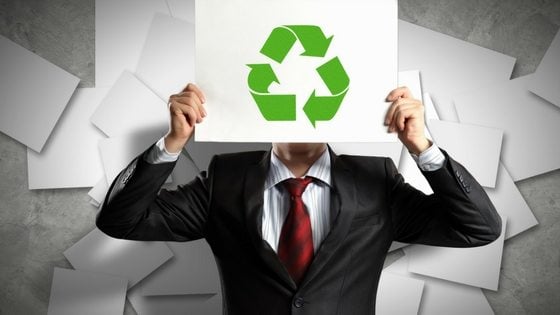

The website – thebalance.com gives a good description of how a MRF works in practice. We quote below:
“Haulers arrive at the MRF and dump the commingled material onto the tipping floor. A front end loader or other bulk material handling equipment then drops into a large steel bin at the start of the processing line. This bin is known as the drum feeder. Inside of the drum feeder, a fast moving drum meters out the commingled material onto the conveyor at a steady rate, while also regulating the density of the material on the conveyor so that it is not packed too tightly together.”
“From there, material goes to a pre-sort station, where workers standing along the conveyor spot and remove any trash, plastic bags or other mistakenly placed material and separate them for appropriate disposition. Large pieces of plastic or steel, including pipes and other large items, can damage the system or expose workers to risk of injury.”
“Larger pieces of cardboard are then removed from the mixed material stream, pushed to the top by large sorting disks turning on axles, while heavier material stays beneath. Smaller sets of the disk may then remove smaller pieces of paper. As materials are separated, they are diverted to separate conveyors for accumulation and baling.”
“Powerful magnets separate steel and tin containers, while an eddy current separator is used to draw aluminum cans and other non-ferrous metals from the remaining co-mingled material. Glass containers can be separated from plastic containers by a density blower, then hammered into the crushed glass, known as cullet. “
“Remaining plastic containers may be sorted manually by workers on the conveyor line, or increasingly, optical sorters are used to identify different materials and colors. Air classification may be used to separate key plastics such as HDPE and PET.”
It is a very interesting process for anyone who likes ingenious technology – and well worth a visit if you can arrange one.
